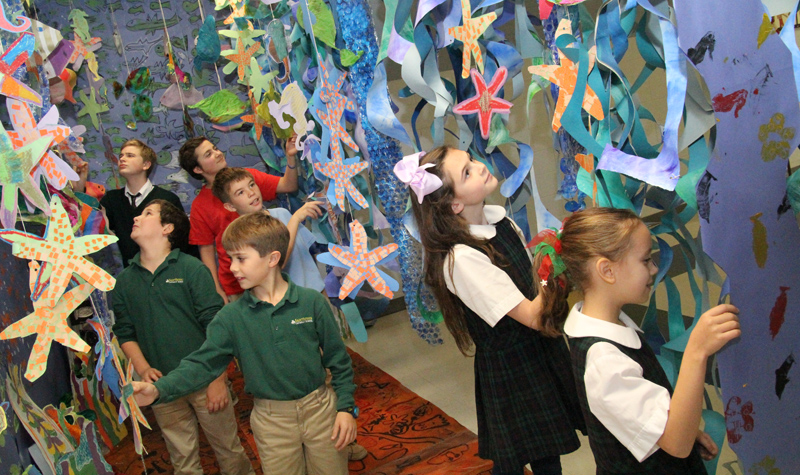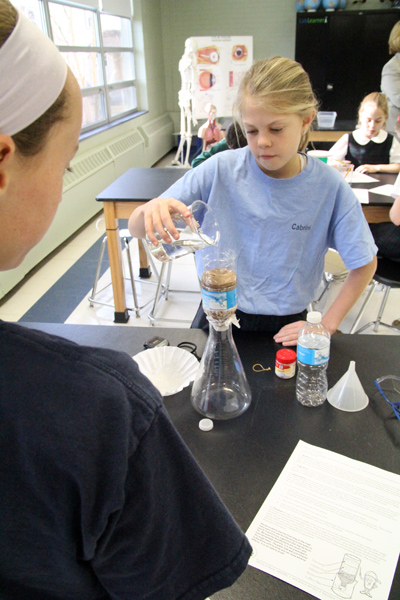The pre-kindergarten to eighth grade students at St. Patrick School in Malvern recently found themselves immersed in water: its life-giving qualities, its spiritual meaning, its expression through the arts, and its scientific manifestations.
It was all part of a month-long curriculum introduced into the school by principal Patricia O’Donnell and taught by the faculty. The educational program is called STREAM, an acronym that stands for Science, Technology, Religion, Engineering, Art and Math.
Even the teachers were impressed with the creativity and enthusiasm of their students as they learned about how to care for water — one of the world’s most precious elements — and how to incorporate the lessons in their own homes and neighborhoods.
[hotblock]
Based on the STEM educational tool — STEM stands for Science, Technology, Engineering and Math — O’Donnell came across a program that added Religion and Art. She decided to implement it at St. Patrick’s, with the theme based on Catholic social teaching.
It seemed fitting to O’Donnell that the project be tied to Pope Francis’ recent papal encyclical, “Laudato Si,” (“On Care for Our Common Home”) in which the pope expresses concern for the environment and other issues such as over-development of land and consumerism.
“The faculty decided to focus on water (which) would be kind of fun for the students,” O’Donnell said. “From there, the teachers worked at each grade level.”
Melissa Rockovich teaches religion and English Language Arts to seventh and eighth graders. Her students read and discussed the papal encyclical, and how it relates to taking care of the earth’s water. The lessons were tied into a fundraiser to benefit Water.org, an organization that provides solutions aiming to change lives through safe water and sanitation.
Several activities revolved around that fundraiser: For two weeks, the children drank nothing but water, and there was a dress down day during which all the kids wore blue. They also studied areas of the world where clean water is scarce. The children also made rain barrels from which water they purified can be used to water plants.
By the end of November, Rockovich’s classes raised a total of $1,300 for Water.org.
Among the books the students read as part of the course was “Long Walk to Water” about a boy named Salva Dut, the only member of his family to survive while escaping from war-torn Sudan. Another book told of young girls in Africa who walk all day in the hot sun just to get some water.
[hotblock2]
Those stories were an eye-opener for seventh-grade student Maggie Devine.
“It made me realize how lucky we are to have water from a faucet,” Maggie said. “It was striking to me to see how people don’t have water.”
Kathy McGinn teaches two fourth-grade classes, and her hands-on science lessons included activities to help her students understand pollution and water. The kids learned how to make purifiers using soda bottles, cotton and coffee filters. They were surprised at how much cotton and filters they went through before the water they were using looked clear, McGinn said.
She also teaches religion, so she took the children to church to put water from the baptismal font into small containers. They also put some of the water into a vessel, and now bless themselves with it whenever they enter the classroom.
They also took their containers of holy water home to bless their families, their pets and their houses.
Fourth grader Deaglan O’Hara doused his cat, Libby, who “wasn’t impressed,” he said, but added that he and his classmates are willing to raise money for materials that people in Africa can use to dig wells so they don’t have to walk long distances to get water.
“I liked the hands-on experience with this and the science,” he said.
Students as well as teachers contributed to the success of STREAM at St. Patrick, McGinn said.
“The skills the kids showed and their understanding about how everything is interconnected were amazing,” she said. “They just loved it.”
PREVIOUS: Blessed Teresa parishioners focus on performing Corporal Works of Mercy
NEXT: Social services’ leader named to head archdiocese’s outreach ministries





Awesome Job Saint Pat’s. I miss each and every one of you. Keep up the great work. Wishing everyone at St. Pat’s a Healthy and Happy 2016 !
Great Job and Congratulations! Faculty and Students.